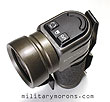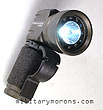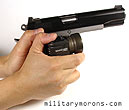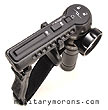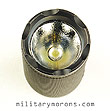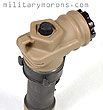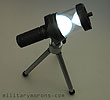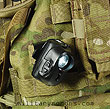Personal Illumination Page 1 Page 2 Page 3 Page 4 Page 5 Page 6
TO VIEW FULL SIZE IMAGES: USERNAME and PASSWORD are both "mm"
| Firstlight USA Tomahawk and Liberator 4/13/08 - From Firstlight USA come the Tomahawk and Liberator; two lights for military, law enforcement and other professionals that are ergonomically designed to fit application-specific demands for those jobs. Both lights offer different solutions to the problems faced with conventional hand-held lights, when used as weapon lights or when multi-tasking. Tomahawk - The Tomahawk is named, presumably because of its 90° angled, tomahawk-like head (like the old USGI angle flashlight). It's available in five models, each with different light configurations. The one shown here is the Tomahawk MC (Multi-Colour), which is a mil-spec version with white, red and blue output with three brightness levels. Here's a rundown of the specs on the Tomahawk MC:
Description - The Tomahawk's main components
comprise of the bezel, which is screwed onto the lamp housing. The
bezel has a single white LED with reflector, surrounded by six red
LEDs and six blue LEDs. The control panel is located on top of the
lamp housing. A padded battery sleeve covers the battery housing,
which acts as the main handle of the light. It holds two CR123 batteries
and has a threaded cap on the bottom. There's a steel retention clip
and a finger loop attached between the battery housing and the lamp
housing. Both are adjustable and removable.
|
|
Operation - The Tomahawk MC is controlled by the buttons on the control panel. There is an elongated semi-circular shaped momentary control, a constant-on button (I/O) and cycle control (three arrows in a circle). There's also a padlock symbol indicator between the buttons to indicate when the lock-out mode is engaged.
Using the Tomahawk - The Tomahawk can
be used with the index or middle finger through the finger loop, depending
on the size of your hand. The recommended way is with the index finger
through the loop. Used this way, the light can be flipped around to
the outside of the hand, leaving it on the index finger while the
hand is free to be used to grab or hold an object. I have relatively
small hands, and used either way, I had no trouble reaching all buttons
with my thumb. The white LED is bright and the beam is focused with
a large spill beam for illuminating a large area of a room. I found
the Tomahawk easier to point in the right direction and activate when
used with a pistol than a conventional hand-held light. The metal
clip is useful as the light can be clipped to your pants, a belt or
a vest so it's facing forward, leaving your hands completely free.
You can't do that with most conventional lights - they either point
up or down. The Tomahawk will also stand up when placed on a flat,
level surface and can be used to illuminate a work area. The Tomahawk
is shorter than most 2-cell conventional lights, but wider. So, there's
a give and take. It's still small enough to put on a pocket, and with
the clip, no sheath is necessary for belt or pants wear.
|
|
Liberator - The Liberator is something quite different as far as lights go. At first glance, it kinda looks like a staple gun. It consists of a 90° angle-head LED light, attached at the top to control panel housing with a handle that goes around your hand. This places the light on the outside of the hand, leaving the palm side free for grasping. Firstlight describes it as 'hands free' (since it's not held in the hand and leaves the hand free), 'hands-directed' (it goes where the hand goes and can be directed/pointed in practically any direction), and 'hands-enabling' (so you can use your hands as you normally would). The Liberator is available in three different models, with the Liberator ST (strobe) shown here. The Liberator uses a 3-watt Lumileds Luxeon Star Emitter with a reflector. The specs on the Liberator ST are as follows:
Description - The main components of
the Liberator are the main light/battery housing, control panel housing
(the horizontal 'bridge'), and the handle/strap. The light/battery housing
rotates 180° where it's attached to the bottom of the control panel
housing. There are detents at 0°, 90° and 180°, plus two
other fine-adjust detents of 10° shy of the 0° and 180°
positions. The battery housing screws into the light housing and holds
the two CR123 batteries. A metal belt/molle-ready clip is attached to
the back of the light housing.
|
|
Operation - Like the Tomahawk, the Liberator is controlled via buttons on the top of the control panel housing.
Fitting the Liberator - The Liberator is first adjusted to fit your hand before use. The hand pad is first moved along the control panel housing in its notches so that it is snug but comfortable on the back of the hand. The velcro strap is then adjusted and secured. Utility Position - This is with the light rotated in the 90° position (in-line with the control panel housing), and the handle is held like a staple gun. Depending on the size of your hand, your thumb operates all the buttons on top. The constant-on and cycle buttons can also be activated with the other hand or by pressing the top against an object. This is a very comfortable way of holding the light as the wrist isn't bent, and the hand is in a natural position. The light is also easily transitioned to the Tactical position on the back of the hand if hands-free usage is required. Tactical position, general use - the Liberator is simply slid over the hand as far as it'll go, with the hand pad on the back of the hand. The momentary button is operated by the thumb and the other buttons activated with the other hand. The head is rotated to the 0° or 180° position, depending on whether you're using it on the left or right hand. The Tactical position utilizes the same hand orientation as the Utility position, except that you have full utility of the hand for holding or grabbing objects. Using the Liberator with firearms - Both the Utility
and Tactical Positions can be used with a firearm. The Liberator comes
with an excellent user's manual and CD which illustrate all the techniques.
I'll touch on them briefly here. With the Utility position, the Liberator
is held alongside the pistol in a two-handed grip. The light on the Liberator is a tightly focused and clear beam with a wide and useful spill beam. I did not see any flaws in the beam. Firstlight is still working on the proper pouch for the Liberator - it's currently supplied with an Uncle Mike's pouch which encloses only the battery/light housing, not the handle. Shown here is a Tactical Tailor radio pouch, which fits the Liberator quite well. Firstlight might be offering a modified version as an option, specifically made for the Liberator. There are those that prefer lights attached to their weapons as you've got a pretty normal firing grip. However, some don't like it for two reasons - they don't think it should be used for searching, and bad guys seem to aim at lights. Those that use handhelds can hold them away from the body, move them around and strobe while searching, but the weapon grip suffers. With the Liberator, you can do both pretty well. I think that the Liberator has many applications besides the LE/military arena. In either the Utility or Tactical positions, it's a comfortable, ergonomic light to use for general use. Where it shines (literally), is in the Tactical position, allowing the hand to be used. You can climb a ladder, grasp tools, perform tasks etc, all without putting the light down. They take a little getting used to, but once you have it down, you'll see how versatile they are.
|
|
8/21/08 Update - A new carrier/accessory for the Tomahawk is now available, called the TRS (Tactical Retention System). It's a holster that provides quick access to the Tomahawk. Not only that, but the Tomahawk can be turned on in the holster and rotated in different directions. It's not a 'holster' or pouch, but more of a platform that the Tomahawk attaches to. The TRS has two main components - the sleeve and the base/platform. The sleeve has dovetail that slides into a corresponding interface on the platform. To install the sleeve on the Tomahawk, the lamp housing is unscrewed from the battery housing, and the metal clip removed. The bottom battery cap is removed and the foam sleeve is slid off. The large O-ring above the sleeve that acts as a spacer is removed as well. The TRS sleeve then slides onto the battery housing and is reassembled. The Tomahawk can rotate almost 180° in the sleeve. There are two platforms; the Molle-Lok and Tek-Lok (made by Blade-tech). The Molle-Lok is of course, molle compatible. The base is attached to dual malice clips. These can be attached either vertically or horizontally for vertical or horizontal carry of the Tomahawk. The belt-compatible platform has a Tek-Lok attached to the base. The base itself has the corresponding dovetail for the Tomahawk to slide and click into. A spring loaded clip locks the Tomahawk into the platform. A button on top is then pressed to unlock the clip, and the Tomahawk can be unholstered. If you mount the platform horizontally, the Tomahawk is inserted and retrieved from the side. It can be pointed up or down. When the Tomahawk is vertically mounted, it rotates to the left or right. I think the vertical orientation is most natural for a belt mount, and takes up the least space. On a Molle vest, the vertical orientation takes up less space, but I'm less likely to use it pointed to the left or right than up and down (and pointed forward). The user will pick the mounting orientation that works best for him.
|
|
New Liberator task light - The Liberator SST is the same as the Liberator ST (with strobe), but with the addition of an LED task light at the end of the control panel housing. It's a white LED light, activated by pressing the cycle control button when the Liberator is off. This little task light provides just the right amount of light to replace a pen light or micro-light, and won't blind you accidentally with too much light and affect your night vision. Belt Holster and LATP - Shown below are the belt holster and LATP (Liberator Adjustable Tactical Pouch) found on First-Light's Accessories page. The belt holster is made from nylon and has a 2-1/4" belt loop on the back. The flap secures the Liberator in the holster and allows access to the momentary split switch for activation in the holster. The Liberator bezel can be rotated while in the holster to point in a useful direction for hands-free use. The LATP is made for First-Light USA by Tactical Tailor. It's fully adjustable and the Liberator is secured by a 550 cord strap, which allows all the buttons to be accessed. It is attached to a molle rig with a single malice clip. Like the belt holster, the Liberator bezel can be rotated for hands-free use of the light.
|
| 9/20/07 - As LED technology advances, we're seeing personal lights get smaller and more powerful, with more modes added instead of simply on/off. Designed for use by military and LE personnel, the EDC-120T (Tactical) is a very compact flashlight from Novatac's Every Day Carry (EDC) line that's suitable for anyone who wants a helluva lot of light in a small package. Measuring only 3.3" long and 1" in diameter, the EDC-120T puts out 120 lumens from a single 3 Watt Seoul P4 LED using a CR123 battery for power. An 85 max lumen model is offered as the EDC-85T. The EDC-120T weighs 3.1 oz with battery. Description - The EDC-120T body is hard-anodized aluminum in a grey-titanium colour is actually made up of three parts - the bezel, center portion, and end cap. The center portion has a wasp-shaped waist which aids in the gripping of the light. All three portions are finely knurled - enough for a decent grip. The threaded interfaces are O-ring sealed and the light is waterproof to 66ft. The front of the bezel is crenulated with shallow scallops that have no sharp edges to tear up a pocket like some other more aggressive toothed or jagged bezels. The bezel/head contains the 'intelligent power supply' which automatically reduces output to preserve the battery as it starts to run down. The coil spring that surrounds the battery transmits the switch signal to the control module in the head. Operation - The EDC-120T is supplied with a removable pocket clip and an O-ring (more on that later). The pocket clip has a hole in it for lanyard attachment. The EDC-120T is controlled by a rubber click switch at the back of the tail cap which is extended and easy to use. The switch is momentary or click on. The EDC-120T is pre-programmed with three output levels and one disorienting strobe feature. The EDC-120T is operated by clicking or pressing the switch. A Click is 1/3 second or less, like a mouse click, and a Press is greater than 1/3 second. Here's the breakdown: From OFF: From ON: Sound confusing? It's easier than it sounds and after playing with it for a short time, you get used to the different operations. The light always turns on to its maximum brightness before you can switch to the lower brightness levels, so if I want a lower brightness level without blinding myself in the dark, I hold the bezel against my shirt, leg or anywhere convenient that doesn't allow any light to spill out, and perform the subsequent clicks after turning the light on. There's about a 1/3 to second delay after clicking for the light to switch from max brightness to a lower level, so I wait for a moment before removing the light and using it. |
| Thorpe Technique - The O-ring is used when the 'Thorpe Technique' is used with a handgun. The O-ring is put in the groove nearest the end cap. The pocket clip must be removed to use the O-ring. The Thorpe Technique for the EDC is similar to the SureFire/Rogers Technique, but the EDC-120T is held directly in line with the pistol, not off to its side. The tail switch is instead pressed against the front of the fingers of the strong hand on the weapon instead of the support hand palm due to the shorter distance from the O-ring to the tail cap. Beam comparison - The EDC-120T has an extremely even white spot beam, with good side spill. I cannot see any occlusions or flaws in the beam whatsoever. The beam is wider than the X200A and not as wide as the X200B. It's brighter than either. Compared to a SureFire 6P with 120 lumen P61 lamp, the EDC-120T has slightly less 'throw', but it's pretty close. The P61 has a wider spot with less side spill. The EDC-120T is small enough to put in a pocket or clip to a belt or waistband where it's virtually unnoticeable until needed. For those who didn't want to carry a 2-cell light because they're bit too long for a pocket, there's no excuse anymore. When held in the palm, it's completely concealed from view from the other side. Since the body of the EDC-120T is 1", it can also be used as a very compact 'scout light' on a carbine by using a single 1" ring for mounting. But, as the name implies, it's really designed for every day carry, and it excels in that role. It's found a semi-permanent home in my pocket. |
 "Thorpe" technique |
| 3/30/07 - When I first saw the new MOLLE light from Pentagon Light, it looked like they had taken the old G.I. D-cell angle flashlight, and put it through a shrinking machine. It's only 3.5" tall, weighs 1.5 oz and fits in the palm of your hand. It has a single 0.5 W white LED which puts out 40 lumens. The body is metal, and contains the single AA battery which provides 3 hours of runtime. The angled head is permanently attached to the body (at least I think it is - I was unable to unscrew it). A red filter is kept at the bottom of the tailcap, and is uncrewed and installed over the lens. The tailcap also houses a small survival compass. Initially, I didn't think the compass worked, as I couldn't get it to settle down and point correctly. Then, I removed the tailcap from the body, and presto! it worked. I guess the metal body interferes with the compass. Obviously, the compass cannot be used in the dark if the light is your only illumination. There's a spring clip on the body which can be rotated. The light can be clipped to a vest, shirt etc, or placed through MOLLE webbing, as long as there's enough slack in the webbing to accomodate the diameter of the body. The on/off switch is the little black button on top of the head. Pressing down lightly on it turn the light on momentarily. Press it harder, and a faint 'click' is heard, and the light stays on. I'd prefer more is a positive detent, but that's just me. Just behind the switch is a bungee/dummy cord loop for tethering the light. The light puts out a wide, very even beam with a brighter spot in the center. With the red filter, the light output is much reduced - suitable for close-up tasks only. The angled head makes it natural to point, without any weird position of the hand and wrist. Attaching the light to a vest provides hands-free lighting. It's a handy, practical little light, and when bought from CountyComm, comes with a nylon MOLLE pouch to put it in. |
| 2/14/07 - Safety Systems Corp is offering a replacement tailcap for most hand-held flashlights that offers an additional feature - a strobe function. Called the Lightsaver Blitzer tailcap, it's a direct replacement for the standard tailcap on a number of SureFire systems. It's available to retrofit SureFire incandescent lights like the G2, Z2, G2Z, G3, 6P, 9P, C2, C3, M2, M3, M3T, M4, L5, L6, M951, M961, M971, M981 and most SureFire Classic Universal Weapon light systems. Caps are in development for other brands/models of lights. As of yet, they are not offering Blitzer caps for LED versions due to circuitary differences, and this cap will only work on incandescent bulbs. (Update 9/2008 - the replacement Blitzer tailcap I have does work with LED bulbs. I tested it with a SureFire P60L lamp and TNVC Q5 Cree LED drop in, with 6P and C2 lights). It's intended to provide additional functionality to the current light system while costing less than a standard tail cap. Shown below are the first production and second production tailcaps. The only difference is that the newer one is slightly crenulated - it will be offered as the standard model. The Blitzer is made out of aerospace-grade aluminum with a knurled texture. Finish is Type III Hardcoat anodizing in a grey colour which is a close-enough match for my Centurion. It will also be available in black. The crenulated version also has a small hole for a split-ring for lanyard attachment. The Blitzer does not have a momentary-on feature - clicking the rubber button clicks it 'on' and 'off'. Holding down the button puts it in strobe mode. This cycles the bulb at approximately seven times a second. This function can either be used for distraction, or signalling. I used the word 'distraction' instead of 'disorientation' because the strobe function used with an incandescent bulb has a different effect than that of an LED light. With an LED, the light turns on an off almost instantaneously - creating a very quick flash of bright light alternating with darkness (assuming you're in a dark environment). With an incandescent bulb, the filament takes time to 'ramp up' and heat to full brightness, and when power is cut, spends some time cooling off. It's a very short amount of time, which we don't normally notice. However, when used as a strobe, the time between flashes is quicker than the filament is allowed to cool completely, so it doesn't go completely dark between flashes. The time spent at full power (due to the ramp-up time) is shorter than that of an LED, so the human eye perceives the incandescent strobe as not going completely dark or reaching full brightness. The perception to the eye is that it isn't as bright or disorienting as an LED strobe. A workaround is to use a brighter bulb - when using the P61 120 lumen bulb in my lights it was much more effective than the standard P60, 65 lumen bulb. Also, the effect it has is different for different people. I'm sort of used to experimenting on myself and might be jaded, but to someone like my wife, it's enough for her to turn her head away and get pissed off at me. I tried it on another buddy, and while he didn't find it 'disorienting' like an LED strobe, he found it very distracting and glaring. The amount of ambient light is also an important factor for strobes effectiveness - LED or incandescent - the darker the better to be more effective. As a signal, the strobe function definitely catches your attention very quickly. Update 9/08: Safety Systems Corp is no longer carrying
these. Please do a google search for an alternative source. |
| 12/6/06 - The Phoebus company has been in the lighting equipment industry since 1976 - producing lighting solutions for movies, theatre, events, concerts, architectural, etc. It makes perfect sense that the Phoebus Manufacturing division is using its 30 years of lighting technology experience and expanding its product line to include tactical flashlights. First up is the PK-01-2CR123 hand held light. It has a 3 watt LED and is powered by two CR123-type batteries. The entire light is machined out of aircraft-grade aluminum and finished in a satin titanium-grey coloured Type III hard-anodized coat for durability and scratch resistance. Overall length of the PK-01-2CR123 is 5.25", and diameter of the bezel is 1.4". It weighs 4.6 oz and puts out 65 lumens. Knurled surfaces on the body and tailcap provide a secure purchase on the light. All machining is very clean and crisp. The tailcap is of the click on, click off type - there is no momentary activation or lock-out feature. A black steel clip is attached to the front of the body, just behind the head with a couple of torx screws. I'd have preferred a different location personally - mounted at the rear just before the tailcap (like the Kroma below). In its current location, the whole head of the light will stick out of a pocket and since it's top heavy, it tends to want to tip out. I'd rather it fit farther down in a pocket, with the head pointed down instead of up (as that's where the weight is), and the thumb would be closer to the tailcap for activation. Phoebus designed it that way so it could be clipped to a cap visor, or some other attach point, and then it'd be pointed at whatever needed to be lighted up, so I see the logic behind the design. |
The head is comprised of two components - the lamp/LED module and the bezel. The bezel unscrews and can be replaced with one with a toothed version which can double as a weapon (sold as the PK-05-2CR123). The bezel has flats to aid in loosening or tightening it, and has scallops around the front. The scallops look attractive, and are also used to see if the light has been left on when placed head down on a flat surface. All interfaces have o-ring seals for water resistance. The beam is very similar in brightness and width to the Kroma reviewed below - I'd call it a 'medium' width beam - not as narrow as some (like the Digilight) and not as wide as others. For more specifications, check out the spec sheet. Next up from Phoebus is the Wilderness Kit, which is a multi-function, convertible flashlight system. It's a personal pocket light that can use either AA or CR123 batteries, a hanging camp lantern, hands-free headlamp, or desk lamp. It comes in a die-cut foam lined box with compartments for each component of the kit. When opening the box, you're faced with an array of machined, anodized, high-tech looking goodies straight out of a James Bond movie. The heart of the kit is the PK-01-CR123 flashlight, also sold by itself. It's a one-watt LED that uses a single CR123 battery and puts out 20 lumens. Overall length is 3.7", with a bezel diameter of 1.1" and a weight of 2.3 oz. So, it's a little guy. It shares the same features and main components as its big brother, the PK-01-2CR123, with the same styling, finish, etc, only it's a miniature version. Again, I'd prefer the pocket clip to be reversed, with the head down inside the pocket, but since it's lighter than the PK-01-2CR123 light, it works well when clipped to a cap visor in its current configuration. The Wilderness Kit comes with the following accessories:
|
How it all goes together - The 2AA body extender
is self-explanatory. With it assembled, the PK-01-CR123 becomes the
PK-01-1AA, with an overall length of 6.3" and weight of 2.9 oz,
putting out 15 lumens. It's similar in size to the old AA Maglite. The Wilderness Kit is a unique-looking package that will appeal to
a wide range of people. It's functional, very well made, and just plain
looks cool. For availability, look up Phoebus's dealer
list. Visit TADGear
for additional photos. |
| 11/22/06 - The SureFire Kroma™ is a selectable-output multi-spectrum LED flashlight. What does that mean? Basically, it has two different levels of lighting in three different colours (white, red and blue). It runs on two 3V 123-type batteries. The Kroma is 5.5" long and weighs 4.9 oz. It's not much larger than the C2 Centurion shown here for size reference. It has knurling on the body and tailcap, and a stainless steel clip. All aluminum surfaces are finished with a Type III hard anodize coating. The bezel is about 1.45" in diameter. The push button tail switch is of the momentary-only type. It doesn't click on and off. More on that later. The head assembly consists of a grooved plastic selector ring, the head, and the bezel. The selector ring has five positions. |
Looking at the front of the light, there are 16 3mm LEDs placed in a circle around a primary 3W white-light LED. The primary LED is surrounded by a TIR (Total Internal Reflection) polymer lens, which gathers all its light and reflects and refracts forward in a tight, even beam. Half of the 16 LEDs are red and the other half are blue. They're spaced alternately around the perimeter of the primary LED. The primary white light LED has two levels - 50 lumens on high and about a lumen on low. The max output of the red LEDs is 6.3 lumens and the blue LEDs, 3.4 lumens. At the low level, both red and blue LEDs produce about .5 lumens. The selector ring controls the colour output:
As mentioned above, the tailcap has a momentary-on function. But it also serves as a mode selector:
So, there are actually 30 different possible combinations of mode and selection. Once you get use to it, it's a lot easier than it sounds here. I know that rotating the selector ring all the way to either side will give me a read or blue high output, so I just go one click in from there for a low output, or put it in the middle for low white. Shown below are some of the combinations. |
The low levels are low enough not to destroy your night-adjusted vision. They're just bright enough to navigate around a dark room. Even though the output of the blue LEDs is lower (in lumens) than the red, the eye perceives it to be brighter. The low levels are useful for closeup work in the dark when you don't want to be blinded by a light that's too bright. The low level white light is useful for map-reading, as some markings on coloured maps can be invisible under coloured light. Up close, the white beam is a square, not round. The high level coloured output is bright enough for most general tasks - looking around a room or campsite etc. The 50-lumen high-level white LED is bright enough to blind an opponent temporarily in the dark indoors, but it'd be nice to have it a bit more powerful. I can see the high level coloured lights being used to search a house for a threat, as they're less likely to betray your presence than the very bright white LED. The high level white light can then be immediately activated by pressing the switch all the way in to disorient or light up a threat if found. Advertised run times are 80 hrs on blue and red low levels, 20 hrs on white low. 8 hrs on red and blue high levels, and 1.5 hrs for white high. The photos below illustrate some of the modes described. I used one camera setting so that the relative brightness could be shown. At that setting, the low coloured levels didn't pick up well. I'm shining the light at a wall about 5 feet away, which best illustrated the dual-level modes. I find myself using the low levels quite often at night, if I don't want to turn on a light and I'm looking for something. It's not a cheap flashlight, but for certain users who need the features, it's worth the investment. You get a lot of different options all in one compact package. |
| SureFire Gen 2 Helmet Light and Z71MOLLE Adapter 2/6/07 - SureFire's Helmet light was introduced more than a year ago at the 2006 SHOT show. Very unconventional in appearance, it was one of the 'must have' gadgets when it first came out. SureFire has improved on the original helmet light, and also developed a MOLLE adaptor for the helmet light to further increase its utility. The helmet light itself is made of flat-dark earth coloured glass filled nylon and neoprene. The watertight battery compartment holds one SF123A battery and is O-ring sealed. The cap has a rubber lanyard to prevent loss. At the front of the light are five 5mm LEDs. The colour of the LEDs depends on the particular model (there are four different available configurations). There are two rubber covered toggle switches at the rear of the light. When the Helmet light was first introduced, these toggle switches were exposed, and could be accidentally turned on if bumped, or when the helmet was stored inside a bag. The 'Gen 2' Helmet light has a hard plastic shroud which protects the two toggle switches from accidental activation. Molded on the shroud are symbols which show what the different switch positions do. The LEDs are turned on with the upper switch - the middle position is off, and flipping it up turns on the primary lights, and toggling it down turns on the secondary colour. The lower toggle switch turns on the IR IFF light on the side, which is a 3mm IR LED beacon which flashes about once a second. Pressing the round button on the side cycles through the intensity of the primary and secondary lights - low, medium and high. The helmet mount is over molded in neoprene for a non-slip surface. It attaches to most ballistic helmets on the left-hand side.A metal bracket clamps to the rim of the helmet and is snugged down with two screws on the side and a set screw on the bottom. It's very secure and does not move. The light slides onto the mount, and locks in place. Depressing a small lever unlocks it and allows it to be removed. It weighs only 3.1 oz with battery. |
| The model shown here is the HL1-A-TN, with white primary LEDs and blue
secondary LEDs. At the high setting, the white LEDs last 6 hrs and output
19.2 lumens, while at the low setting they last for 48 hrs at 1.4 lumens.
VIsit the SureFire link above for more specifications and information
on the other settings. The LED is bright enough for close-up, general
purpose tasks, and the blue setting is a more NV-friendly colour. The
tertiary IRR led, when turned on, emits a barely perceptible red glow
when it flashes.
|
| The SureFire Z71 MOLLE adapter for the helmet light utilizes two columns of PALS webbing. Constructed of glass-filled nylon, the adapter securely mounts to any MOLLE webbing, with little or no sag, as the thickness of the 'feet' take up any slack in the webbing. The two feet are slipped into the two columns of PALS where they lock in place. The mounting head has a spring-loaded detent, and pivots to five pre-set angles - from stowed (down) to past horizontal. The helmet light is installed and removed with the same lever as on the helmet mount. Shown below is the HL1-D-TN variation of the helmet light, with three yellow-green LEDs for the primary light, and two IR LEDs as the secondary. Unlike the tertiary IFF LED on the side which you can visually confirm is operating by looking for the almost imperceptible red glow when it flashes, I could not perceive anything from the IR LEDs without night vision. The MOLLE adapter further increases the versatility of the SureFire helmet light and also provides a good place for storing it when not mounted on the helmet. Contact SureFire for more information and availability.
|
| 2/15/05
- I'll have to admit that a few years ago, I had looked at headlamps
as specialty-use products. Only coalminers or spelunkers used them
I thought. That changed when Petzl first came out with their Tikka.
I bought one and was hooked when I discovered the convenience of hands-free
lighting. Since then, I've been using a Petzl Tikka and Tikka Plus,
and I usually have one with me if I'm carrying a bag of some sort,
or in the car. They've been invaluable in many situations - rummaging
through my pack in the dark, settiing up a tent, working on my car
etc. For close-up lighting, nothing beats a headlamp for convenience
(in my changed opinion). Shown here are but a small sampling of Petzl's
bewieldering array of headlamps; from small, close-up lights to powerful,
long-distance lights. Check out their website
for more info and full specs on all the lamps seen here. |
| Tikka
Plus/TacTikka Plus and Zipka Plus - The Plus models
offer more features than the basic Tikkas. They have 4 LEDs instead
of 3 for slightly greater range/brightness. The Tikka Plus was the
second headlamp I bought, and I think the additional features made
it worth the higher cost. The tilting head is a great feature, allowing
you to angle it precisely. The rubberized membrane switch controls
the 4 settings by rapidly pressing it repeatedly up to four times
to select the different modes - max brightness, optimum, economic,
and intermittent (flashing). I prefer this switch to the sliding Tikka
switch. |
| MYO
5 - The MYO 5 combines the best of both worlds of
a longer distance headlamp and proximity lighting of an LED lamp.
The MYO 5 lamp assembly has a main Xenon halogen lamp, with 5 LEDs
below it. Rotating the lamp bezel turns on the 5 LEDs first, which
can be set at 3 different light levels (optimum, max and economy)
by rotating the bezel on and off quickly. Sounds complicated, but
it's not. The 5 LEDs provide more than enough close-up light for tasks
in the immediate area. Rotating the bezel further turns on the small
Xenon halogen bulb, which is surprisingly bright - enough to reach
past 75 yards. The beam can be focused from spot to flood by rotating
the bezel. A reserve power mode activates when the batteries are almost
spent, using the LEDs to provide low level proximity lighting. |
| 2/24/06
- TacTikka XP - This is the military version of the
popular Tikka
XP that was introduced in '05. The compact yet powerful TacTikka
XP shares all the features of the civilian version. It uses a single
1 watt LED light powered by three AAA batteries. The LED has four
light levels - economic (lowest), optimum, maximum and "boost"
(which almost doubles the maximum setting for momentary use). There
is also a "blink" mode, where the LED flashes on and off
for signalling. The light is turned on and off by depressing a rubber
button (the left one). Pressing it once and leaving it turns it on
at the maximum setting. Pressing it again immediately after first
turning it on toggles it through the optimum, economic and flashing
modes. The button on the right with the lightning symbol is the "boost"
button and when pressed, the LED gives off a very bright light as
long as you hold down the button (an automatic power limiter drops
down to maximum after 20 seconds to prevent overheating of the LED).
On the side of the body is a small window which lights up and flashes
5 seconds after the light is turned on. This is the battery life indicator.
It blinks green when the batteries are fresh, and orange when about
30% of the life remains, then red when they need to be replaced. |
| 9/24/06
- TacTikka XP ADAPT - The TacTikka
ADAPT (and ADAPT system) further adds to the versatility of the
already excellent Tikka XP headlamp (above). The TacTikka XP Adapt
is the same basic headlamp, but with a different back plate. The XP
ADAPT comes with the XP headlamp, an elastic headstrap that now has
an additional 'over-the-head' strap, a clip and universal helmet adapter. |
| The ADAPT clip was designed to
clip onto a jacket, belt, PALS/molle webbing, or just about any place
it fits on. When inserted into a molle slot, there's a hook that prevents
it from being pulled out. The hook is not meant to go under the 2nd
row of PALS webbing, so that the row can be used for pouches. It's
a stable mount for the XP lamp, which just clicks onto the clip. Mounted
on a vest, it can be angled and rotated in a cone, and it can be pointed
in most positions needed. |
| 3/14/07 - e+LITE® - The newest headlamp from Petzl is their first emergency headlamp and by far one of the coolest designs available, the e+LITE. Weighing less than one ounce, the e+LITE is compact and light enough to carry anywhere on your person. It comes in a small, pill-shaped plastic case about 3.25" long and 1.6" wide - smaller than most cell phones. The cap of the case is secured by a rubber O-ring that goes around the entire case. A molded belt loop will accomodate 1.5" belts. The first thing I noticed was how small and light the e+LITE is. It's dwarfed when compared side-by-side to the already compact TacTikka XP. A narrow but comfortable elastic band is attached to the base, and is adjusted by the red cord lock in the back. The lamp can be worn on the head, neck or wrist. The rectangular button on the cord lock is used to unscrew the battery cover (a coin can be used as well). The e+LITE is powered by two coin CR2032 lithium batteries, the same type that power mini red dot sights like the docter, and also illuminated scope reticles like the Nightforce, so they're relatively common. Petzl claims that the light can be stored 10 years with the batteries and still be operational. |
| The E+LITE is shock resistant, weather resistant (water proof to 3 ft), and functions in temperatures from -22°F to 140°F. The headlamp itself is tiny - only about 1.6" wide and 1.3" tall. It has three white LEDs arranged in a triangle with one red LED in the middle. They're recessed into the face of the body for protection. The white LEDs put out 16 lumens on max power, for 35 hours of battery life. There is a red rotary switch that rotates to each setting/mode. The switch is 'locked' in the clockwise-most position (looking at the front of the light). This prevents the switch from accidental activation. Rotating the switch counter-clockwise, the next detent is 'off'. The rest of the detents are White economy level, White maximum level, White strobe/flashing, Red strobe, Red, and another 'off' setting (so you can turn it off in either direction). The headlamp is attached to the red plastic base by a ball-and-socket arrangement, which allows the headlamp to rotate 360°. It can be tilted down, pointed off to the side, and even flipped so that it faces the base, which is the recommended 'protected/storage' position. The elastic headstrap is removable from the base, allowing the metal spring clip on the base to be used to attach the light to the bill of a cap, a pocket, or whatever object it'll fit on. I've used it clipped to the waistband of my running shorts turned to the strobe mode when running at night for a bit more visibility to cars. Worn on the head, the e+LITE is barely noticeable, and I really like the range of motion afforded by the ball and socket configuration. I can point it virtually in any direction. It's also surprisingly bright - the maximum white setting is too bright for reading or close-up work - use the economy setting for most indoor tasks. The maximum white setting is bright enough to light up the ground when running or walking in the dark. Even though the e+LITE is meant to be a backup/emergency light, tucked away in a car, pocket, emergency kit or backpack and forgotten until needed, I think it'll see a lot of daily use from people wanting a versatile, extremely lightweight headlamp. It's something you can't just have only one of. |
TangoDown SureFire Helmet Light Ball Cap Mount
| 2/15/08 - TangoDown has introduced a nifty mount for the SureFire Helmet light reviewed above that fits on any ballcap brim, so you can clip your SF Helmet light on to your cap for hands-free use. It's called the SFHL-001 Ball Cap Mount, and is made in FDE, Black and Foliage green. The mount consists of two plastic halves, and two small self-tapping screws. The mount works just like the SF Helmet mount does; the U-shaped interface is slid over the mount until the tab locks. To remove, press down on the tab until it unlocks then slide the light off the mount. The mount is installed by positioning the light where you want it on the brim and marking the position of the mount. Two holes are then poked through the brim. The backing plate is then placed over the holes and the self-tapping screws tightened until snug. The mount is unobtrusive and barely noticeable until you need it.
|
ATTENTION! PLEASE DO NOT LINK DIRECTLY TO MY IMAGES
-
IT RESULTS IN MY BANDWIDTH ALLOCATIONS BEING EXCEEDED,
AND MY PAGES GO DOWN. THANKS!
/ . PLEASE
OBSERVE AND RESPECT OUR COPYRIGHT! . /
©opyright by MilitaryMorons.com. All Rights Reserved. Reproduction, Duplication,
Distribution Strictly Prohibited.
Unless mentioned otherwise, content and images are the
property of militarymorons.com and are not in the public domain.
They are not to be used without
permission. Please Contact
me for permission to use any images or content herein.


